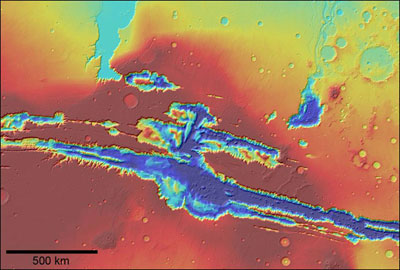Valles Marineris:
The Making of Mars' Giant Canyon System
By:
Jeffrey Andrews-Hanna
Colorado School of Mines
| When: | Friday, March 09, 2012, 10:30 a.m. to 11:30 a.m. Join us for coffee beginning at 10:00 a.m. |
| Where: | Seminar Conference Room, 10100 Burnet Road, Bldg 196-ROC, Austin, Texas 78758 |
| Host: | Jack Holt, UTIG |
Click for a Live Broadcast.

Abstract
Despite a lack of plate tectonics, the planet Mars experienced significant tectonic activity early in its history. The most enigmatic of Mars - tectonic features is the enormous Valles Marineris canyon system - a set of rectangular troughs up to 2000 km long, 200 km wide, and 8 km deep, located within the Tharsis volcanic province. This tectonic canyon system is without parallel in the Solar System, and its formation has remained an outstanding problem.
In this talk, I will present a new paradigm for understanding the formation of Valles Marineris, driven by the unique tectonic and geodynamic environment of the Tharsis region. Tharsis is an enormous volcanic load, supported above its equilibrium isostatic level by the strength of the elastic lithosphere. Volcanic loading at Tharsis over a topographic step separating Mars' highlands and lowlands led to a focused belt of extension at the present-day location of Valles Marineris.
This extension led to the formation of long parallel dikes, which served to weaken the lithosphere. These dikes removed the flexural support from large blocks of crust, allowing them to subside to their isostatic level. As the troughs formed, they filled with sediments, driving further subsidence. The drying of the martian climate then exposed these sediments to aeolian erosion, emptying much of the volume of the troughs.
The end result is the formation of a set of parallel, partially sediment-filled, 8 km deep troughs. While the details of the process are complex, the formation of this unique canyon system can be understood in terms of the simple concepts of loading, flexure, and isostasy.




